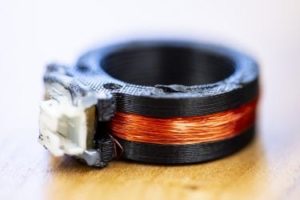
A team of researchers at the University of Washington showed off the AuraRing, their high-resolution optical gesture tracking system.
The AuraRing uses an oscillating electromagnetic field generated by an index finger-sized ring — which contains a coil of wire wrapped 800 times around it — powered by a tiny battery generating only 2.3 milliwatts of power. The magnetic waves are then measured by three sensor coils housed in a wristband worn by the user that determine the ring’s five degrees of freedom (5Dof) orientation at any point in time.
This optical tracking differs from the computer vision-based tracking found in early AR and VR headsets in its higher degree of precision. This could lead to use cases like the wearer being able to ‘write’ legibly by waving their finger through the air without touching any surfaces and have its movements measured by the sensors in the wristband and then translated into writing on a screen.
Other potential applications include input tap or flick gestures that can be used to play a game or control a screen from a distance, and because the AuraRing uses magnetic waves to sense movement, researchers suggest that even a finger that is visually obscured can have its movements registered by the sensors.
The imagery for the wristband portion of the device that houses the sensors is currently a clunky prototype, but the researchers envision adding those same sensors to a smartwatch or other wrist-worn device.
“You would still have all the capabilities that today’s smartwatches have to offer,” said co-lead researcher Farshid Salemi Parizi, “but when you want the additional benefits, you just put on your ring.”
The research for the AuraRing was funded by the University of Washington’s Reality Lab, along with Facebook, Futurewei, and Google.
Source: VentureBeat

Follow Us